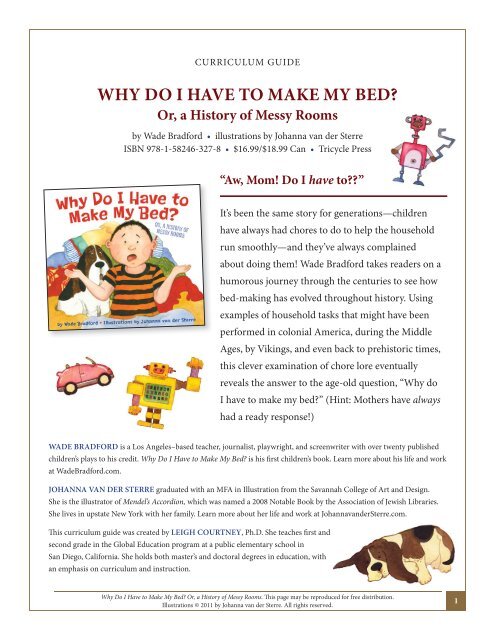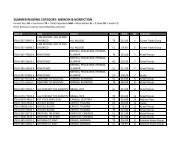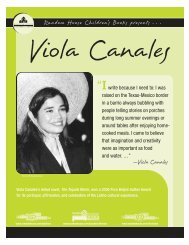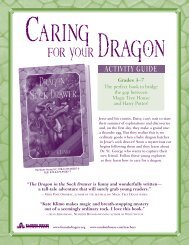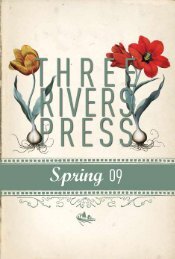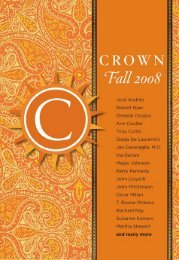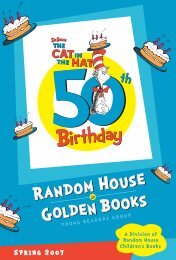WHY DO I HAVE TO MAKE MY BED? Or, a History ... - Wade Bradford
WHY DO I HAVE TO MAKE MY BED? Or, a History ... - Wade Bradford
WHY DO I HAVE TO MAKE MY BED? Or, a History ... - Wade Bradford
You also want an ePaper? Increase the reach of your titles
YUMPU automatically turns print PDFs into web optimized ePapers that Google loves.
CURRICULUM GUIDE<br />
<strong>WHY</strong> <strong>DO</strong> I <strong>HAVE</strong> <strong>TO</strong> <strong>MAKE</strong> <strong>MY</strong> <strong>BED</strong>?<br />
<strong>Or</strong>, a <strong>History</strong> of Messy Rooms<br />
by <strong>Wade</strong> <strong>Bradford</strong> • illustrations by Johanna van der Sterre<br />
ISBN 978-1-58246-327-8 • $16.99/$18.99 Can • Tricycle Press<br />
“Aw, Mom! Do I have to??”<br />
It’s been the same story for generations—children<br />
have always had chores to do to help the household<br />
run smoothly—and they’ve always complained<br />
about doing them! <strong>Wade</strong> <strong>Bradford</strong> takes readers on a<br />
humorous journey through the centuries to see how<br />
bed-making has evolved throughout history. Using<br />
examples of household tasks that might have been<br />
performed in colonial America, during the Middle<br />
Ages, by Vikings, and even back to prehistoric times,<br />
this clever examination of chore lore eventually<br />
reveals the answer to the age-old question, “Why do<br />
I have to make my bed?” (Hint: Mothers have always<br />
had a ready response!)<br />
WADE BRADFORD is a Los Angeles–based teacher, journalist, playwright, and screenwriter with over twenty published<br />
children’s plays to his credit. Why Do I Have to Make My Bed? is his fi rst children’s book. Learn more about his life and work<br />
at <strong>Wade</strong><strong>Bradford</strong>.com.<br />
JOHANNA VAN DER STERRE graduated with an MFA in Illustration from the Savannah College of Art and Design.<br />
She is the illustrator of Mendel’s Accordion, which was named a 2008 Notable Book by the Association of Jewish Libraries.<br />
She lives in upstate New York with her family. Learn more about her life and work at JohannavanderSterre.com.<br />
Th is curriculum guide was created by LEIGH COURTNEY, Ph.D. She teaches fi rst and<br />
second grade in the Global Education program at a public elementary school in<br />
San Diego, California. She holds both master’s and doctoral degrees in education, with<br />
an emphasis on curriculum and instruction.<br />
Why Do I Have to Make My Bed? <strong>Or</strong>, a <strong>History</strong> of Messy Rooms. Th is page may be reproduced for free distribution.<br />
Illustrations © 2011 by Johanna van der Sterre. All rights reserved.<br />
1
2<br />
BEFORE READING<br />
• As a class, brainstorm a list of things around the house that the students’ parents repeatedly ask them to do.<br />
Have each student pick one item from the list to illustrate. Share the illustrations with the class and lead a<br />
discussion about how parents’ constant reminders about completing chores make the students feel. Does<br />
everyone in the class have similar chores? Do they feel the same way or diff erently when they are reminded to<br />
do their chores? Why do they think their parents give them chores to do?<br />
• Have the students ask their parents, grandparents, and older family friends what types of chores they did<br />
when they were children. Share those fi ndings in a class discussion.<br />
DISCUSSION QUESTIONS<br />
Aft er reading Why Do I Have to Make My Bed?, discuss the following questions:<br />
• Besides having to make their beds, what chores do the children in the story have to do? How do they compare<br />
with your chores? What era’s chores seemed most diff erent from yours?<br />
• Were you surprised by any of the chores assigned to the children in the story? Did any of their chores seem<br />
like they’d be fun?<br />
• If you could switch places with one of the children in the story, which era would you choose? Why?<br />
Why Do I Have to Make My Bed? <strong>Or</strong>, a <strong>History</strong> of Messy Rooms. Th is page may be reproduced for free distribution.<br />
Illustrations © 2011 by Johanna van der Sterre. All rights reserved.
AFTER READING<br />
• Sometimes people are resistant to doing a chore because they fi nd the chore diffi cult. Using the worksheets on<br />
pages 4 and 5, design a brief “how to” book describing how to make a bed. Create illustrations and descriptive<br />
sentences that show how to make a bed using your step-by-step directions. Use words like fi rst, next, and<br />
fi nally when writing your steps. Once you have the steps completed, cut the pages where indicated and put<br />
your book in order. Staple along the left side to bind your book.<br />
• In each period of history, the author describes how the child feels about making his bed by using a simile<br />
or comparison: “ruffl ed as a hen,” “bothersome as a badger,” “mad as a wet cat.” Th ink of how you feel when<br />
asked to do chores either that you do not want to do (pulling weeds in the garden) or enjoy (walking your<br />
dog). Choose one of these strong feelings and create a simile for it. Write your comparison on the simile<br />
worksheet (guide page 6) and create torn paper artwork to accompany your simile using colored construction<br />
paper and glue (but no scissors!). Create a “Simile City” bulletin board or display area in your classroom for<br />
the fi nished pieces.<br />
• Using vocabulary from the story, work in groups of three to four students to create a vocabulary skit<br />
dramatizing the meaning of the selected word. Each group will be assigned a vocabulary word from the<br />
story and will then work together to create a short skit that demonstrates the defi nition of the word. In<br />
what context would you use your word? Can you create a skit that uses the word and shows the class what it<br />
means? Suggested vocabulary from the story to use in the vocabulary skits:<br />
cantankerous<br />
fetched<br />
sheared<br />
sacred<br />
tunic<br />
caribou<br />
linen<br />
plague<br />
Why Do I Have to Make My Bed? <strong>Or</strong>, a <strong>History</strong> of Messy Rooms. Th is page may be reproduced for free distribution.<br />
Illustrations © 2011 by Johanna van der Sterre. All rights reserved.<br />
bothersome<br />
stalagmites<br />
• Why Do I Have to Make My Bed? stretches across many centuries. Divide your class into small<br />
research teams to fi nd out a few facts about children’s lives in each time period presented in the book.<br />
Th e information pages, “Chores Th rough the Ages,” at the back of the book can serve as<br />
a reference tool for the research groups. Have the children design fact cards on 4" x 6"<br />
index cards to present their fi ndings. Th e fact cards should be illustrated and<br />
include a caption with the fact (see sample card, guide page 8). Stretch sturdy<br />
string or a clothesline in the classroom. Have the research teams use clothespins<br />
to attach their fact cards to the “timeline” in the correct chronological<br />
order. Th en students may walk the timeline from early people to the present<br />
day to learn more about the lives of children through the centuries.<br />
• In the story, author <strong>Wade</strong> <strong>Bradford</strong> creates chores for the<br />
children based on typical activities and lifestyles during each<br />
of the eras profi led in the book. Match the chore with the<br />
time period in the Name Th at Era worksheet (guide page 7).<br />
3
CUT HERE<br />
✁<br />
4<br />
How to Make a Bed<br />
by_______________________________________________<br />
____________________________________________________<br />
____________________________________________________<br />
____________________________________________________<br />
____________________________________________________<br />
____________________________________________________<br />
____________________________________________________<br />
____________________________________________________<br />
____________________________________________________<br />
____________________________________________________<br />
____________________________________________________<br />
Why Do I Have to Make My Bed? <strong>Or</strong>, a <strong>History</strong> of Messy Rooms. Th is page may be reproduced for free distribution.<br />
Illustrations © 2011 by Johanna van der Sterre. All rights reserved.
CUT HERE ✁<br />
____________________________________________________<br />
____________________________________________________<br />
____________________________________________________<br />
____________________________________________________<br />
____________________________________________________<br />
____________________________________________________<br />
____________________________________________________<br />
____________________________________________________<br />
____________________________________________________<br />
____________________________________________________<br />
____________________________________________________<br />
____________________________________________________<br />
____________________________________________________<br />
____________________________________________________<br />
____________________________________________________<br />
Why Do I Have to Make My Bed? <strong>Or</strong>, a <strong>History</strong> of Messy Rooms. Th is page may be reproduced for free distribution.<br />
Illustrations © 2011 by Johanna van der Sterre. All rights reserved.<br />
5
6<br />
Simile Worksheet<br />
Photocopy this page as many times as you need to create one sentence for each student.<br />
Have the students fi ll in the blanks and glue their sentence to the top of a piece of<br />
construction paper. Beneath the sentence, have each student create torn paper<br />
artwork to accompany his/her simile using colored construction paper and glue<br />
(but no scissors!). Display the sheets in a “Simile City” section of your classroom.<br />
I am as _______________________________________ as a _______________________________________<br />
when my ____________________________________ asks me to ___________________________________ .<br />
I am as _______________________________________ as a _______________________________________<br />
when my ____________________________________ asks me to ___________________________________ .<br />
I am as _______________________________________ as a _______________________________________<br />
when my ____________________________________ asks me to ___________________________________ .<br />
I am as _______________________________________ as a _______________________________________<br />
when my ____________________________________ asks me to ___________________________________ .<br />
I am as _______________________________________ as a _______________________________________<br />
when my ____________________________________ asks me to ___________________________________ .<br />
I am as _______________________________________ as a _______________________________________<br />
when my ____________________________________ asks me to ___________________________________ .<br />
Why Do I Have to Make My Bed? <strong>Or</strong>, a <strong>History</strong> of Messy Rooms. Th is page may be reproduced for free distribution.<br />
Illustrations © 2011 by Johanna van der Sterre. All rights reserved.
Name That Era!<br />
Match the chore in the fi rst column with the era in which it may have been<br />
performed in the second column. Draw a line to connect the two.<br />
1. Hung britches to dry a. Present Day<br />
2. Fetched water from the pump b. 1762—Colonial America<br />
3. Hunted mammoth c. 875—Th e Age of the Vikings<br />
4. Milked the yak d. 1801—Pioneer Days<br />
5. Picked up aft er gladiators e. 40,000 BC—Prehistoric Times<br />
6. Put the dishes in the dishwasher f. 1144—Th e Middle Ages<br />
7. Picked up my lasso, marbles, and rag dolly g. 1911—Turn of the Century<br />
8. Dusted the Captain’s spyglass h. 121—Th e Roman Empire<br />
9. Patched Father’s war wounds i. 1953—Th e Fabulous Fift ies<br />
10. Gave water to the pyramid builders j. 1630—Th e New World<br />
11. Dusted my rock ’n’ roll records k. 1000 BC—Ancient Egypt<br />
Answers: 1. b; 2. g; 3. e.; 4. f; 5. h; 6. a; 7. d; 8. j; 9. c; 10. k; 11. i<br />
Why Do I Have to Make My Bed? <strong>Or</strong>, a <strong>History</strong> of Messy Rooms. Th is page may be reproduced for free distribution.<br />
Illustrations © 2011 by Johanna van der Sterre. All rights reserved.<br />
7
8<br />
Sample Fact Card<br />
1762<br />
Children helped take care<br />
of the family’s livestock,<br />
including collecting eggs<br />
from the henhouse.<br />
Why Do I Have to Make My Bed? <strong>Or</strong>, a <strong>History</strong> of Messy Rooms. Th is page may be reproduced for free distribution.<br />
Illustrations © 2011 by Johanna van der Sterre. All rights reserved.


